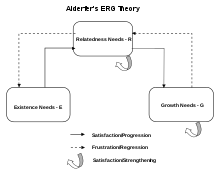ERG theory
ERG theory is a theory in psychology proposed by Clayton Alderfer.

Alderfer further developed Maslow's hierarchy of needs by categorizing the hierarchy into his ERG theory (Existence, Relatedness and Growth). The existence group is concerned with providing the basic material existence requirements of humans. They include the items that Maslow considered to be physiological and safety needs. The second group of needs is those of relatedness – the desire people have for maintaining important interpersonal relationships. These social and status desires require interaction with others if they are to be satisfied, and they align with Maslow's social need and the external component of Maslow's esteem classification. Finally, Alderfer isolates growth needs: an intrinsic desire for personal development. These include the intrinsic component from Maslow's esteem category and the characteristics included under self-actualization. Alderfer categorized the lower order needs (Physiological and Safety) into the Existence category. He fit Maslow's interpersonal love and esteem needs into the Relatedness category. The Growth category contained the self-actualization and self-esteem needs. Alderfer also proposed a regression theory to go along with the ERG theory. He said that when needs in a higher category are not met then individuals redouble the efforts invested in a lower category need. For example if self-actualization or self-esteem is not met then individuals will invest more effort in the relatedness category in the hopes of achieving the higher need.[1]
Publication
This theory was published originally in "Organizational Behavior and Human Performance".[2]
See also
- Engel's law, an economic model for how well basic needs are met
- Maslow's hierarchy of needs
- Fundamental human needs, Manfred Max-Neef's model
- John Curtis Gowan
- Juan Antonio Pérez López, spontaneous and rational motivation
- Metamotivation
- Murray's psychogenic needs
- Need theory
- Need
References
- Design in the Manufacturing Firm syllabus University of Washington Industrial Engineering course syllabus. Retrieved on 07-17-2011.
- Alderfer, Clayton P. (1969). "An empirical test of a new theory of human needs". Organizational Behavior and Human Performance. 4 (2): 142–75. doi:10.1016/0030-5073(69)90004-X.
External links
- A Theory of Human Motivation, original 1943 article by Maslow.